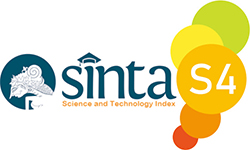PENGGUNAAN INDIKATOR TEKNIKAL PADA RETURN PASAR SAHAM DI INDONESIA
Abstract
Abstract. This study uses indicators Moving Averages, Relative Strength Index, Stochastic Oscillator, Parabolic Stop and Reverse, Moving Average Convergence Divergence, and Rate of Change for the approach of Technical Analysis in the Indonesian capital market. Technical analysis indicators are applied to three indices, namely the Composite Stock Price Index, Sri Kehati Index, and LQ45 for the period 30 April 2010 to 30 April 2021. The best technical analysis indicator in trading strategy is SMA 3 from Stochastic-14 which can generate returns yearly over the index by 13,239% for JCI, 25.043% for SRI-KEHATI, and 20.664% for LQ45. The results of the resilience analysis show that technical analysis indicators are more profitable for sub period 2 (1 November 2015 to 30 April 2021) compared to sub period 1 (30 April 2010 to 31 October 2021).
Abstrak. Penelitian ini menggunakan indikator Moving Averages, Relative Strength Indeks, Stochastic Oscillator, Parabolic Stop and Reverse, Moving Average Convergence Divergence, dan Rate of Change untuk menyelidiki kegunaan pendekatan Analisa Teknikal di pasar modal Indonesia. Indikator analisa teknikal diterapkan pada tiga indeks yaitu Indeks Harga Saham Gabungan, Indeks Sri Kehati, dan LQ45 selama periode 30 April 2010 sampai dengan 30 April 2021. Indikator analisa tekniknal yang paling baik dalam strategi trading adalah SMA 3 dari Stochastic-14 yang dapat menghasilkan return tahunan melebihi indeks sebesar 13.239% untuk IHSG, 25.043% untuk SRI-KEHATI, dan 20.664% untuk LQ45. Hasil dari analisa robustness menunjukkan bahwa indikator analisa teknik lebih menguntungkan untuk sub periode 2 (1 November 2015 s/d 30 April 2021) daripada sub periode 1 (30 April 2010 s/d 31 Oktober 2021).
Full Text:
PDFReferences
Cheung, W., Lam, K. S., & Yeung, H. (2011). Intertemporal profitability and the stability of
technical analysis: evidences from the Hong Kong stock exchange. Applied
Economics, 43(15), 1945-1963. doi: 10.1080/00036840902817805
Cohen, G., & Cabiri, E. (2015). Can technical oscillators outperform the buy and hold strategy? Applied Economics.
Fifield, S. G., Power, D. M., & Donald Sinclair, C. (2005). An analysis of trading strategies in
eleven European stock markets. The European Journal of Finance, 11(6), 531-548.
doi: 10.1080/1351847042000304099
Han, Y., Yang, K., & Zhou, G. (2013). A New Anomaly: The Cross-Sectional Profitability of
Technical Analysis. Journal of Financial and Quantitative Analysis, 48(5), 1433-1461.
doi:10.1017/S0022109013000586
Karamoy, H., & Tulung, J. E. (2020). The Effect of Banking Risk on Indonesian Regional Development Bank. Banks and Bank Systems, 15(2), 130-137
Karamoy, H., & Tulung, J. E. (2020). The Effect of Financial Performance and Corporate Governance To Stock Price In Non-Bank Financial Industry. Corporate Ownership & Control, 17(2), 97-103.
Kolková, A., (2017). Entrepreneurship on the financial markets based on the selected indicator
technical analysis. Innovation Management, Entrepreneurship and Sustainability (IMES
, 426-435. Retrieved 2 28, 2021, from https://www.ceeol.com/search/chapter
detail?id=544901
Malhotra, N., Tandon, K., & Tandon, D. (2015). Testing the Empirics of Weak Form of Efficient Market Hypothesis: Evidence from Asia-Pacific Markets. The IUP Journal of Applied Finance, 21(4), 18. Retrieved 2 28, 2021, from https://papers.ssrn.com/sol3/papers.cfm?abstract_id=2706331
Metghalchi, M., Kagochi, J., & Hayes, L. (2021). A technical approach to equity investing in South Africa: A tale of two indexes. Cogent Economics & Finance. doi: 10.1080/23322039.2020.1869374
Mojambo, G. A., Tulung, J. E., & Saerang, R. T. (2020). The Influence of Top Management Team (TMT) Characteristics Toward Indonesian Banks Financial Performance During the Digital Era (2014-2018). JMBI UNSRAT (Jurnal Ilmiah Manajemen Bisnis dan Inovasi Universitas Sam Ratulangi)., 7(1).
Mutmainah, M., & Sulasmiyati, S. (2017). Analisis Teknikal Indikator Stochastic Oscillator Dalam Menentukan Sinyal Beli Dan Sinyal Jual Saham (Studi Pada Sub Sektor Konstruksi Dan Bangunan Di Bursa Efek Indonesia Periode 2014-2016). Jurnal Administrasi Bisnis, 49(1), 1-8.
O'Sullivan, P. (2018). The Capital Asset Pricing Model and the Efficient Markets Hypothesis: The Compelling Fairy Tale of Contemporary Financial Economics. International Journal of Political Economy, 225-252.
Suleman, M. T., Hamid, K., Shah, S. Z., & Akkash, R. S. (2010). Testing the Weak Form of Efficient Market Hypothesis: Empirical Evidence from Asia-Pacific Markets. Social Science Research Network. Retrieved 2 28, 2021, from https://papers.ssrn.com/sol3/papers.cfm?abstract_id=2912908
Teixeira, L. A., Oliveira, A. L. I. (2010). A method for automatic stock trading combining echnical analysis and nearest neighbor classification, Expert Systems with Application, 37 Issue
(10), 6885-6890. doi: 10.1016/j.eswa.2010.03.033.
Ye, F., Zhang, L., Zhang, D., Fujita, H., & Gong, Z. (2016). A novel forecasting method based on multi-order fuzzy time series and technical analysis. Information Sciences, 367, 41-57.
doi:10.1016/j.ins.2016.05.038
DOI: https://doi.org/10.35794/jmbi.v9i2.39798
Refbacks
- There are currently no refbacks.

This work is licensed under a Creative Commons Attribution-NonCommercial-ShareAlike 4.0 International License.






